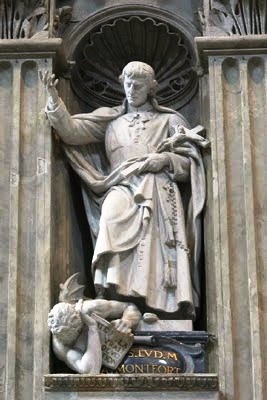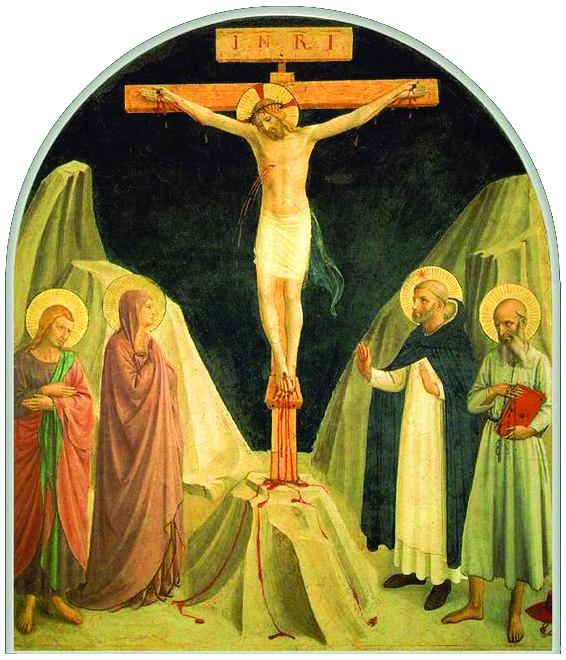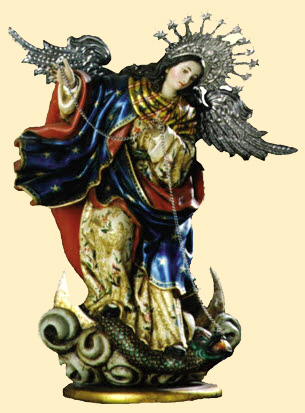by Plinio Corrêa de Oliveira
The great Marian apostle Saint Louis Marie Grignion de Montfort. “We must do everything with Mary.”
We must do everything with Mary, that is to say, in all our actions we must look upon Mary, although a simple human being, as the perfect model of every virtue and perfection, fashioned by the Holy Spirit for us to imitate, as far as our limited capacity allows. In every action then we should consider how Mary performed it or how she would perform it if she were in our place. For this reason, we must examine and meditate on the great virtues she practiced during her life, especially:
1) Her lively faith, by which she believed the angel’s word without the least hesitation, and believed faithfully and constantly even to the foot of the Cross on Calvary.
2) Her deep humility, which made her prefer seclusion, maintain silence, submit to every eventuality and put herself in the last place.
3) Her truly divine purity, which never had and never will have its equal on this side of heaven.
And so on for her other virtues.
Remember what I told you before, that Mary is the great, unique mold of God, designed to make living images of God at little expense and in a short time. Anyone who finds this mold and casts himself into it is soon transformed into Our Lord because it is the true likeness of Him.
The author: Plinio Corrêa de Oliveira. To do all our actions with Mary is to have Mary as our model.
To Do All Actions With Mary Means Essentially to Take Mary As Our Model
The idea to perform all our actions with Mary means to have Mary as our model. Why should we have Mary as our model and perform our actions with Mary? Why does the word “with” apply in this case?
It applies because of the idea of the mold that Saint Louis describes in his book. He shows the difference between a sculptor making a statue and someone who makes a statue from a mold. Whether the mold be of metal or wood, the task is much simpler. One only needs to put the plaster in, let it dry and a figure is obtained. Whereas the work of a sculptor, with hammer and chisel, is much greater and riskier as a piece of the stone or marble can just break off. A mold on the contrary is quick, inexpensive and without flaw as the figure thus molded will be an exact copy of the original.
Saint Louis says that Our Lady is the mold of Our Lord Jesus Christand that she is also our mold. In other words, if we, as plaster, mold ourselves entirely according to her, since she is the mold of Christ, we will be like Our Lord. So to have her as our model is to have her as our mold. If she is our mold, we will do everything with her. This is the meaning of doing everything “with her.”
To Have Mary As Our Model Presupposes a Type of Soul Who Is Constantly Aware of Everything Happening Within It
How can we have Mary as our model? He gives some elements for this. First, it presupposes that the soul knows Our Lady so it has a clear idea of the ideal that needs to be imitated.
Second, the soul must have her in mind in everything it does. This presupposes that the soul has the habit of interior vigilance and of continuous meditation. This means that for each action I need to have Our Lady as my model. I should pay good attention to everything I do. Is it in accordance with Our Lady or not? So much vigilance over ourselves is necessary. At all times my soul needs to see what is happening within it and judge it.
Faith, Humility and Purity: Virtues That Are Eminently Counter-Revolutionary
We have seen that Saint Louis indicates we should imitate Our Lady’s virtues. And as we imitate them, he points out three main ones: faith, humility and purity. These are three eminently counter-revolutionary virtues.
Faith is the foundation of all virtue. Without it no virtue can truly be called a virtue. It is the root of all virtue. If a plant does not have a healthy root system, the whole plant suffers because its entire, or almost entire, nutritional system will be defective.
In this light the Catholic Church is the soil. Our root is the faith with which our souls emerge into the blessed soil of the Catholic Church.
Faith Is Confidence In God By Which, In the Most Adverse Circumstances, One Is Certain That God’s Goodness Will Not Fail
The soil of the Catholic Church is always fertile. The problem is to know if our faith, if the root of our virtue is alive. Saint Louis de Montfort takes the word faith with a twofold meaning. The first is the belief in everything that the Church teaches and the second is a confidence in God by which, in the most adverse circumstances, one is certain that God’s goodness will not fail.
Saint Louis then gives the supreme example in which Our Lady proved her faith in both ways: Our Lady at the foot of the Cross. On Calvary she above all was tested in her belief. Because it is really terrible that she, the Mother of God, knowing that her Son was the innocent victim par excellence, had to see her Son treated as if He was being pursued by the justice of God and of men.
Our Lady at the foot of the Cross proves her faith in both ways. In the most adverse circumstances she believes without the slightest vacillation that Our Lord is fulfilling His mission and she is fulfilling hers. On the other hand, she has an unlimited confidence in the goodness of God. She knows that these torments will redound in the glory of the Resurrection, the Ascension, and Pentecost, and glorify His name in every epoch of History.
The Passion: A Mysterious Aspect of the Life of Our Lord Jesus Christ
There is a mystery surrounding Our Lord. From the moment of His Agony in the Garden of Olives, one has the impression the full wrath of the Heavenly Father was unleashed against Him and that from then on everything is suffering.
We witness an impressive sequence of torments and pain that He bears with a grandeur, serenity and determination that goes from the first moment of sweating blood and being afraid until the moment in which He exclaims from the height of the Cross: “My God, My God, why hast Thou forsaken me?” And then there is the consumatum est as if saying: “The cup is full and I have drunk it all.”
Our Lady, either through revelations or from the moment she meets Him, is present at every moment and believes without the slightest vacillation. She believes in what she should believe which is that this is a terrible injustice. Her Son offered Himself to expiate all the sins of the world and, as such, the wrath that these sins deserve is unleashed against Him. He is sublimely crushed by the Divine wrath. And with this He redeems the world. This is the highest and most profound meaning that He is fulfilling His mission and she is fulfilling hers.
She believes this at every moment and this faith upholds her at the foot of the Cross without any vacillation. On the other hand, she has an unlimited confidence in the goodness of God. And she knows that these torments will redound in the glory of the Resurrection, the Ascension, and Pentecost. It will glorify His name in every epoch of History. The culminating glory will be at the end of the world when the whole of humanity, for all eternity, will be at His feet when He pronounces the final judgment: those who were His, go to Heaven; and those who were not, go to Hell.
In other words Our Lady could see this immense glory that would be the reward the Divine Goodness would give as a result of such a great fidelity. She was at the foot of the Cross sustained by this sublime hope and firmly believing in it. This was Mary.
Even If Tempests Wage Against Us Leading Us to Believe That Goodness Does Not Exist, We Should Confide Blindly That the Moment When This Will Become Manifest Will Come
We must believe everything the Church teaches. Therefore we must believe in everything supernatural and the total goodness of Our Lady. We must also continue to believe blindly in this goodness even when the tempests lead us to believe otherwise. This goodness will manifest itself concretely in our lives. She will make her great goodness manifest at some point.
This is Our Lady’s state of soul amidst the difficult circumstances of life. And this is the attitude she requires us to take as we gaze at her while thinking: “She is our Mother and our Queen. If she went through this, so must we. She gave the example and we must follow.”
Of course there is an immense difference which is that Our Lady cannot be compared to any created being. No creature can be compared in any way with Our Lady. Whether we consider the most brilliant angel, the most saintly saint, none can be compared in any way to Our Lady. The most beautiful grain of sand and the most beautiful jewel are more similar to each other than the highest Cherubim or Seraphim or saint are to Our Lady.
She knows this and she knows our weakness. And because of this she is also Mother of Mercy in another sense. She doesn’t just ask of us strangulating sacrifices or scalding afflictions. She is also our consoler, our comforter in our afflictions.
If We Had To Suffer the Pains Our Lady Endured, We Would Disintegrate
In other words she comes to the aid of those who suffer. She diminishes their pain, eases their afflictions and intervenes in thousands of ways to show she is a mother. She smiles and helps us to understand that we will not have to go through what was required of her. Because if we had to suffer the pain that she had to endure in just one instance of the Passion of Our Lord, we would disintegrate.
For example, if we had to love Our Lord Jesus Christ as she loved Him and had to meet Him along the Way of the Cross all disfigured, we would disintegrate. She knows this and much of what she suffered at that moment was so we would not have to suffer as much. This is why she is called Queen of Martyrs as well as Comforter of the Afflicted. There is almost a contradiction of terms here because a Queen of Martyrs should teach martyrs how to suffer and a Comforter of the Afflicted helps a person not to suffer or even takes it away. However she is Comforter of the Afflicted. At times she gives us strength to bear an affliction while at others she takes the suffering away.
So at Our Lady’s feet we should present those afflictions we cannot bear and say to her: “My Mother, see my weakness. If you do not give me exceptional strength, I will not be able to bear it, so come quickly to my aid.” Or one could say: “My Mother, I do not have the courage to ask you for the extra strength needed, but I do ask you to smile at my weakness, to pardon my weakness, to have pity on my weakness. I may be able to bear this at some point. If I am not able, pardon me and take me to Heaven nonetheless because you are Mother of all mercies.”
This is the attitude that our faith teaches us to take. Here we have Our Lady as a model of faith in light of our own personal afflictions.
Our Lady’s humility is not a sentimental humility of one who denies the qualities given by God. But rather it is to understand that she should attribute to God everything she has, as well as not wanting to be more than she is.
Humility Is To Understand That We Must Attribute All We Have To God
We could speak of Our Lady’s humility. Of course it is not a sentimental humility of one who denies the qualities given by God. We see this in the Magnificat when she says “all generations shall call me blessed.”
Where is Our Lady’s humility? It is to understand that she should attribute to God everything she has as well as not wanting to be more than she is. This is humility. One could object: “But if she was everything, how could she want to be more than she was?” Man’s capacity for misery is bottomless. This was not a problem for her since she was conceived without Original Sin. But many times, he who has more envies he who has less because, not satisfied with what he has, he wants what the other has also.
So let us say that the person is a great violinist, but sees another who whistles well. Whistling is something inferior, but he, nonetheless, can be envious: “That person whistles well. I want to know how to whistle too!” Our Lady did not envy those who were less. She felt well just where she was. This is true humility.
And finally Saint Louis de Montfort speaks of Our Lady’s purity. What more can one say about the purity of Our Lady? She is the Holy Virgin of virgins. She is the Virgin Mother before, during and after giving birth. She is the model of models of purity. She is the fountain of purity.
If we have a lively faith and deep humility – in other words, a hierarchical and sacral sense of things whereby we attribute everything to God – as well as unblemished purity, we will be counter-revolutionaries par excellence.
To Do Everything With Mary Is To Be a Perfect Catholic For Our Times
If we have a lively faith and deep humility — in other words, a hierarchical and sacral sense of things whereby we attribute everything to God — as well as unblemished purity, we will be counter-revolutionaries par excellence.
Thus to do everything with Mary is to be a perfect Catholic for our times. If we take her as our model, this becomes very easy as she will help us. We will be like her very quickly as long as we believe entirely in the efficacy of devotion to her. What I am saying is that we need to do everything just as Saint Louis de Montfort says to be very united to her. If we do this, we will obtain everything we need. If we find it difficult to obtain what we ask it is because we are not as united to her as we should be. This is what we should ponder.
In sum, we should ardently ask Our Lady to grant us this vigilance. But, above all, that she help us to understand her most high virtues so we may do everything to be perfect counter-revolutionaries just as she is — the supreme model, source and channel of the Counter-Revolution. If we do this, we will be transformed very quickly.
Read Also:
The True Devotion Trilogy I — “To you, Dear Atheist”
The True Devotion Trilogy II — “Service, a Joy”
The True Devotion Trilogy III — “Obey in Order to be Free”
Consecration to Jesus Christ through Mary
Prof. Plinio Corrêa de Oliveira was a man of profound piety and unshakable faith, and intensely devoted to the Blessed Virgin Mary, to whom he consecrated himself according to the method of Saint Louis de Montfort. His commentaries on excerpts from Saint Louis de Montfort’s famous book Treatise on True Devotion to the Blessed Virgin (paragraph No.260, reproduced just below), were given during a conference to members of the TFP in 1972. They have been translated and adapted for publication without his revision.






No comments:
Post a Comment